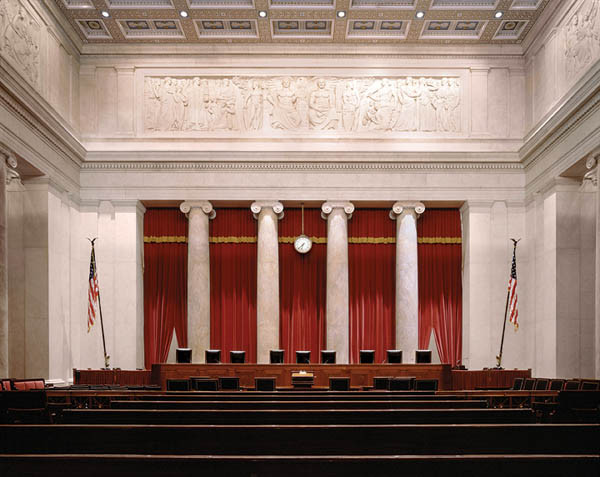A divided Supreme Court on Thursday ruled that the use of affirmative action in admissions programs at two universities was unconstitutional.
 Two cases were in front of the nine Justices: Students for Fair Admissions v. President and Fellows of Harvard College and Students for Fair Admissions v. University of North Carolina. In these cases, the Court was reviewing the constitutionality of affirmative action in higher education, and if institutions of higher education could still use race as a factor in their student admissions process.
Two cases were in front of the nine Justices: Students for Fair Admissions v. President and Fellows of Harvard College and Students for Fair Admissions v. University of North Carolina. In these cases, the Court was reviewing the constitutionality of affirmative action in higher education, and if institutions of higher education could still use race as a factor in their student admissions process.
Link: Read the Court’s Affirmative Action Decision
In the majority decision (which was consolidated), Chief Justice John Roberts wrote that “because Harvard’s and UNC’s admissions programs lack sufficiently focused and measurable objectives warranting the use of race, unavoidably employ race in a negative manner, involve racial stereotyping, and lack meaningful end points, those admissions programs cannot be reconciled with the guarantees of the [14th Amendment's] Equal Protection Clause.”
Roberts said that “at the same time, nothing prohibits universities from considering an applicant’s discussion of how race affected the applicant’s life, so long as that discussion is concretely tied to a quality of character or unique ability that the particular applicant can contribute to the university. Many universities have for too long wrongly concluded that the touchstone of an individual’s identity is not challenges bested, skills built, or lessons learned, but the color of their skin. This Nation’s constitutional history does not tolerate that choice.”
Roberts concluded that race-based admissions considerations could only be used in cases of strict scrutiny, a situation where there is a compelling governmental interest, and any action must be narrowly tailored to achieve that interest.
Related to the North Carolina case, Justice Neil Gorsuch concurred with the majority and also concluded “that the Equal Protection Clause of the Fourteenth Amendment does not tolerate this practice. I write to emphasize that Title VI of the Civil Rights Act of 1964 does not either.”
Justice Ketanji Brown Jackson did not take part in the Harvard case, but she dissented in the North Carolina case. Justices Elena Kagan and Sonia Sotomayor dissented in both cases, which were announced jointly.
In her dissent, Justice Sotomayor argued that "the Equal Protection Clause of the Fourteenth Amendment enshrines a guarantee of racial equality. The Court long ago concluded that this guarantee can be enforced through race-conscious means in a society that is not, and has never been, colorblind. In Brown v. Board of Education, the Court recognized the constitutional necessity of racially integrated schools in light of the harm inflicted by segregation and the ‘importance of education to our democratic society.’”
“Today, this Court stands in the way and rolls back decades of precedent and momentous progress. It holds that race can no longer be used in a limited way in college admissions to achieve such critical benefits,” she concluded.
Justice Jackson dissent was related to the North Carolina case. "Gulf-sized race-based gaps exist with respect to the health, wealth, and well-being of American citizens. They were created in the distant past, but have indisputably been passed down to the present day through the generations. Every moment these gaps persist is a moment in which this great country falls short of actualizing one of its foundational principles—the “self-evident” truth that all of us are created equal,” Jackson wrote. “Yet, today, the Court determines that holistic admissions programs like the one that the University of North Carolina (UNC) has operated, consistent with Grutter v. Bollinger (2003), are a problem with respect to achievement of that aspiration, rather thana viable solution (as has long been evident to historians, sociologists, and policymakers alike).”
Students for Fair Admissions asked in both cases if the Court should overrule its precedent in Grutter and hold that institutions of higher education cannot use race as a factor in admission. Other questions were related to Title VI of the Civil Rights Act and the effect of race-neutral alternatives on academic quality.
The Supreme Court’s precedents on affirmative action dated back to 1978, when a divided Court came to a mixed decision in Regents of the University of California v. Bakke.
Allan Bakke, a white male in his thirties, twice applied for admission at the school but was rejected, partially because of his advanced age. Compared to the special admittees of UC Davis’s affirmative action program, he beat every student in every metric in both of his application classes.
Bakke, exasperated by the rejections, filed suit, contending that the University of California violated the Equal Protection guarantee of the 14th Amendment and the Civil Rights Act. Ironically, he argued, a law that was passed to promote equality was being employed for the opposite purpose.
Affirming the lower court, Justice Lewis Powell and four of his colleagues determined that specific racial quotas in university admissions are unconstitutional. But Powell also joined the remaining four Justices in affirming that a racial background could be one of many factors in an admissions decision. In Powell’s view, such a policy did not specifically exclude anyone from admission.
Twenty-five years later, in Grutter v. Bollinger (2003), the Court affirmed its decision in Bakke by ruling that the University of Michigan Law School’s race-conscious admissions policy was constitutional because it did not involve the use of explicit quotas. But Bakke remains fundamental precedent on affirmative action.
Most recently, in June 2016 the Supreme Court affirmed, in a 4-3 decision written by Justice Anthony Kennedy, a lower court ruling that allowed the University of Texas to use a race-conscious admissions policy under the 14th Amendment’s Equal Protection Clause.
Scott Bomboy is the editor in chief of the National Constitution Center.







